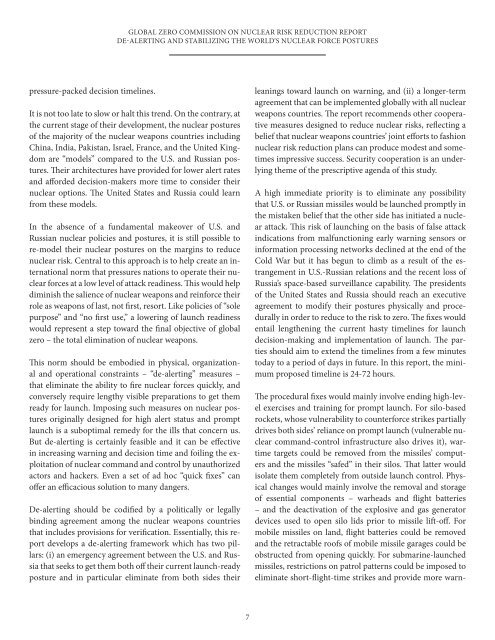global_zero_commission_on_nuclear_risk_reduction_report
global_zero_commission_on_nuclear_risk_reduction_report
global_zero_commission_on_nuclear_risk_reduction_report
You also want an ePaper? Increase the reach of your titles
YUMPU automatically turns print PDFs into web optimized ePapers that Google loves.
GLOBAL ZERO COMMISSION ON NUCLEAR RISK REDUCTION REPORTDE-ALERTING AND STABILIZING THE WORLD’S NUCLEAR FORCE POSTURESpressure-packed decisi<strong>on</strong> timelines.It is not too late to slow or halt this trend. On the c<strong>on</strong>trary, atthe current stage of their development, the <strong>nuclear</strong> posturesof the majority of the <strong>nuclear</strong> weap<strong>on</strong>s countries includingChina, India, Pakistan, Israel, France, and the United Kingdomare “models” compared to the U.S. and Russian postures.Their architectures have provided for lower alert ratesand afforded decisi<strong>on</strong>-makers more time to c<strong>on</strong>sider their<strong>nuclear</strong> opti<strong>on</strong>s. The United States and Russia could learnfrom these models.In the absence of a fundamental makeover of U.S. andRussian <strong>nuclear</strong> policies and postures, it is still possible tore-model their <strong>nuclear</strong> postures <strong>on</strong> the margins to reduce<strong>nuclear</strong> <strong>risk</strong>. Central to this approach is to help create an internati<strong>on</strong>alnorm that pressures nati<strong>on</strong>s to operate their <strong>nuclear</strong>forces at a low level of attack readiness. This would helpdiminish the salience of <strong>nuclear</strong> weap<strong>on</strong>s and reinforce theirrole as weap<strong>on</strong>s of last, not first, resort. Like policies of “solepurpose” and “no first use,” a lowering of launch readinesswould represent a step toward the final objective of <str<strong>on</strong>g>global</str<strong>on</strong>g><str<strong>on</strong>g>zero</str<strong>on</strong>g> – the total eliminati<strong>on</strong> of <strong>nuclear</strong> weap<strong>on</strong>s.This norm should be embodied in physical, organizati<strong>on</strong>aland operati<strong>on</strong>al c<strong>on</strong>straints – “de-alerting” measures –that eliminate the ability to fire <strong>nuclear</strong> forces quickly, andc<strong>on</strong>versely require lengthy visible preparati<strong>on</strong>s to get themready for launch. Imposing such measures <strong>on</strong> <strong>nuclear</strong> posturesoriginally designed for high alert status and promptlaunch is a suboptimal remedy for the ills that c<strong>on</strong>cern us.But de-alerting is certainly feasible and it can be effectivein increasing warning and decisi<strong>on</strong> time and foiling the exploitati<strong>on</strong>of <strong>nuclear</strong> command and c<strong>on</strong>trol by unauthorizedactors and hackers. Even a set of ad hoc “quick fixes” canoffer an efficacious soluti<strong>on</strong> to many dangers.De-alerting should be codified by a politically or legallybinding agreement am<strong>on</strong>g the <strong>nuclear</strong> weap<strong>on</strong>s countriesthat includes provisi<strong>on</strong>s for verificati<strong>on</strong>. Essentially, this <strong>report</strong>develops a de-alerting framework which has two pillars:(i) an emergency agreement between the U.S. and Russiathat seeks to get them both off their current launch-readyposture and in particular eliminate from both sides theirleanings toward launch <strong>on</strong> warning, and (ii) a l<strong>on</strong>ger-termagreement that can be implemented <str<strong>on</strong>g>global</str<strong>on</strong>g>ly with all <strong>nuclear</strong>weap<strong>on</strong>s countries. The <strong>report</strong> recommends other cooperativemeasures designed to reduce <strong>nuclear</strong> <strong>risk</strong>s, reflecting abelief that <strong>nuclear</strong> weap<strong>on</strong>s countries’ joint efforts to fashi<strong>on</strong><strong>nuclear</strong> <strong>risk</strong> reducti<strong>on</strong> plans can produce modest and sometimesimpressive success. Security cooperati<strong>on</strong> is an underlyingtheme of the prescriptive agenda of this study.A high immediate priority is to eliminate any possibilitythat U.S. or Russian missiles would be launched promptly inthe mistaken belief that the other side has initiated a <strong>nuclear</strong>attack. This <strong>risk</strong> of launching <strong>on</strong> the basis of false attackindicati<strong>on</strong>s from malfuncti<strong>on</strong>ing early warning sensors orinformati<strong>on</strong> processing networks declined at the end of theCold War but it has begun to climb as a result of the estrangementin U.S.-Russian relati<strong>on</strong>s and the recent loss ofRussia’s space-based surveillance capability. The presidentsof the United States and Russia should reach an executiveagreement to modify their postures physically and procedurallyin order to reduce to the <strong>risk</strong> to <str<strong>on</strong>g>zero</str<strong>on</strong>g>. The fixes wouldentail lengthening the current hasty timelines for launchdecisi<strong>on</strong>-making and implementati<strong>on</strong> of launch. The partiesshould aim to extend the timelines from a few minutestoday to a period of days in future. In this <strong>report</strong>, the minimumproposed timeline is 24-72 hours.The procedural fixes would mainly involve ending high-levelexercises and training for prompt launch. For silo-basedrockets, whose vulnerability to counterforce strikes partiallydrives both sides’ reliance <strong>on</strong> prompt launch (vulnerable <strong>nuclear</strong>command-c<strong>on</strong>trol infrastructure also drives it), wartimetargets could be removed from the missiles’ computersand the missiles “safed” in their silos. That latter wouldisolate them completely from outside launch c<strong>on</strong>trol. Physicalchanges would mainly involve the removal and storageof essential comp<strong>on</strong>ents – warheads and flight batteries– and the deactivati<strong>on</strong> of the explosive and gas generatordevices used to open silo lids prior to missile lift-off. Formobile missiles <strong>on</strong> land, flight batteries could be removedand the retractable roofs of mobile missile garages could beobstructed from opening quickly. For submarine-launchedmissiles, restricti<strong>on</strong>s <strong>on</strong> patrol patterns could be imposed toeliminate short-flight-time strikes and provide more warn-7


